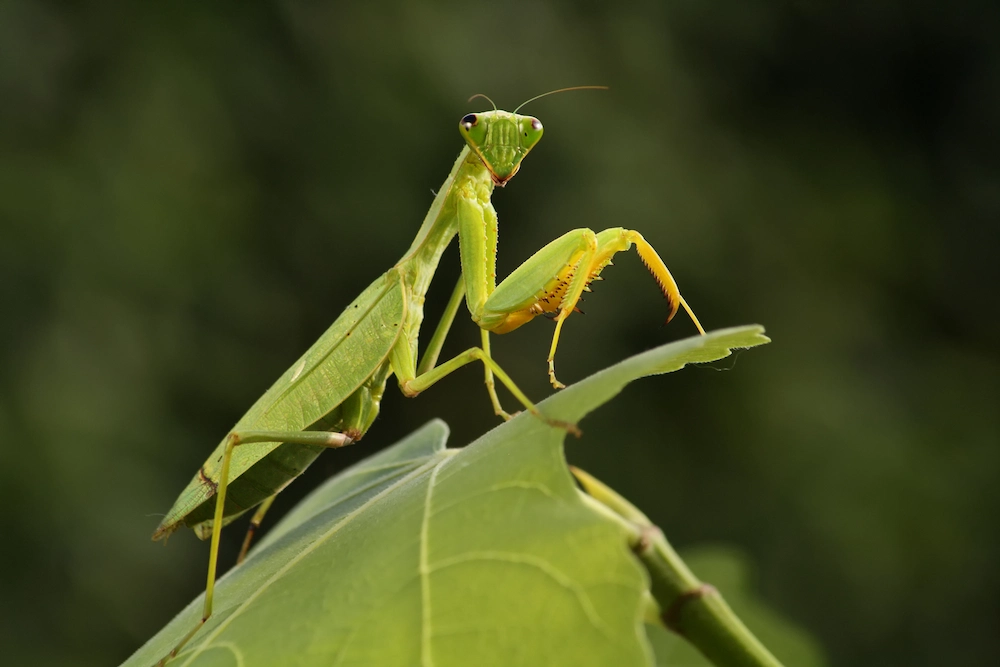Summary: St. Patrick’s Day is the celebration of green, and no one does it better than these green pests. This blog explores the lives and habits of 8 common green pests in Texas in order to see how they cause issues for people. Romney Pest Control provides customized solutions to persistent pest problems.
Happy St. Patrick’s Day from Romney Pest Control! There are quite a few symbols attached to this holiday — leprechauns, horseshoes, delicious corned beef — but the most common is green. This is the color of every shamrock-based decoration you can imagine, but it’s also the color of certain bugs.
If you’re wondering why so many garden pests are green, the simple answer is camouflage. Tiny pests like them don’t stand a chance against their predators out in the open. They spend all of their time around grass and plants, so why not blend in? Let’s take a brief look at the emerald-hued lives of 8 green pests and learn how they mastered the art of camouflage.
Aphids
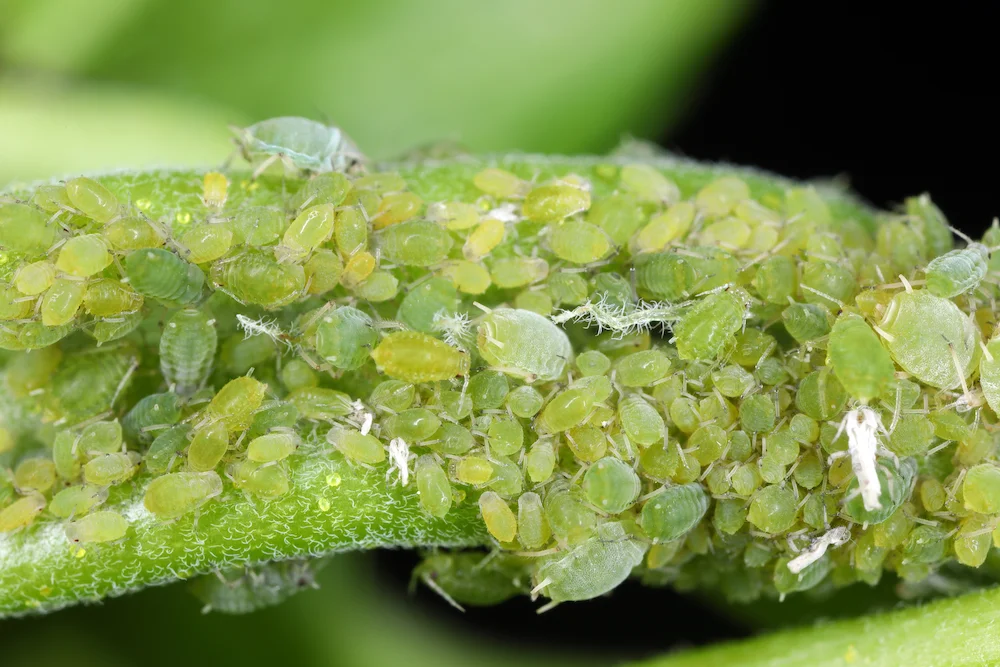
One of the most infamous green pests of all time, aphids are experts at hiding. They’re not only close to the same color as their home plants, they also stay on the undersides of leaves. Aphids pierce the stem and veins of the leaves they live under, then extract the sap. This sap gives aphids a lot of nutrients while simultaneously draining the leaves of their own nutrients.
Aphids are such a light green that they border on translucent when they’re on green leaves. Winged aphids spread the love to other plants by flying over and producing 2 to 3 young a day, so infestations grow slowly yet steadily. They’re active year-round in Texas because of the warm temperatures. This gives them more opportunities to ruin our greenery by transmitting plant diseases and killing each leaf’s cell tissue.
Grasshoppers

Grasshoppers are one of the pests that are gifted enough to change their coloring to blend in — sort of. They’re limited to green, gray, and brown, so grasshoppers need to live in natural surroundings that they can match. They usually stay in tall grass for extra protection. Since grasshoppers can hop up to 30 inches high, they have no problem escaping their lofty habitat.
Although they seem harmless to us, grasshoppers are a major enemy of farmers and gardeners. Clouds of locusts (a type of grasshopper) have been a threat to crops since the ancient times. These green pests eat all kinds of plants and grasses, leaving jagged holes in the greenery. They’re even more active in the dry heat of late summer and early fall. If you have any crops you care about, you’ll want to keep an eye out for these hoppers.
Green Lacewings

The green coloring isn’t the most vibrant on these pests, but it’s noticeable when they move away from their plant habitats. Green lacewings are light green and up to 3/4 of an inch long. Their trademark wings are delicate and lacy, which helps them blend in with trees and plants. These bugs are nocturnal, which also aids in their mission to hide from predators.
The larvae of green lacewings are beneficial because they eat other pests. Their favorite food is aphids, so adult green lacewings often try to lay their eggs near aphid populations. Speaking of which, the adults eat pollen, nectar, and honeydew (from aphids), so they join the ranks of bees and butterflies in the gardens. Green lacewings are sometimes mistaken for dragonflies, but lacewings are shorter and don’t dart while they fly.
June Beetles
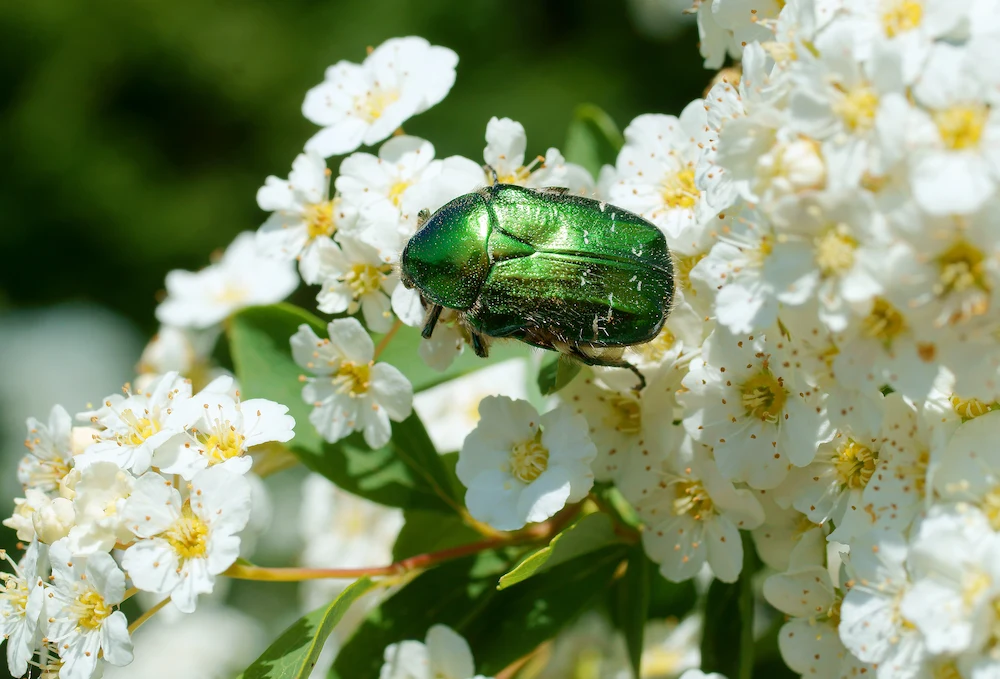
June beetles — aka “June bugs” — are a type of scarab beetle. There are about 100 species of these beetles in the country. The emerald ones that we see have a mixture of green and bronze coloring on their hard shells. The underside of their wings are also green, which gives them a major advantage when they take flight among the greenery.
These green pests are often found on ornamentals, plant roots, turf grass, fruit trees, and Christmas trees. They prefer soft, overripe fruit to unripe fruit, and their favorites are pears, plums, and apples. This destructive behavior begins in their larval stage. You may have seen white grubs ruining your lawn by chowing down on the grass roots. Well, white grubs are the larvae of June beetles (gasp!) and often stay in the same yard during their adulthood.
Katydids

Katydids are essentially the kings of camouflage among green pests. They have double the advantage with their green coloring and leaf-shaped bodies. These green pests are about 1.5 inches long and have lengthy antennae. Katydids typically stay in tall trees for both protection and access to their favorite foods, including leaves, aphids, spider mites, and thrips.
One of the most unique features of the katydid isn’t their leafy body shape, although that is pretty interesting. It’s their method of communication. Male katydids use stridulation, the act of rubbing their wings together to create their noises. This is similar to how crickets rub their legs together to chirp. The strange chirping sound of katydids is used to warn others of danger or to attract a mate. It sounds like an insect voice filter over someone saying, “Katydid! Katydid!”
Praying Mantises
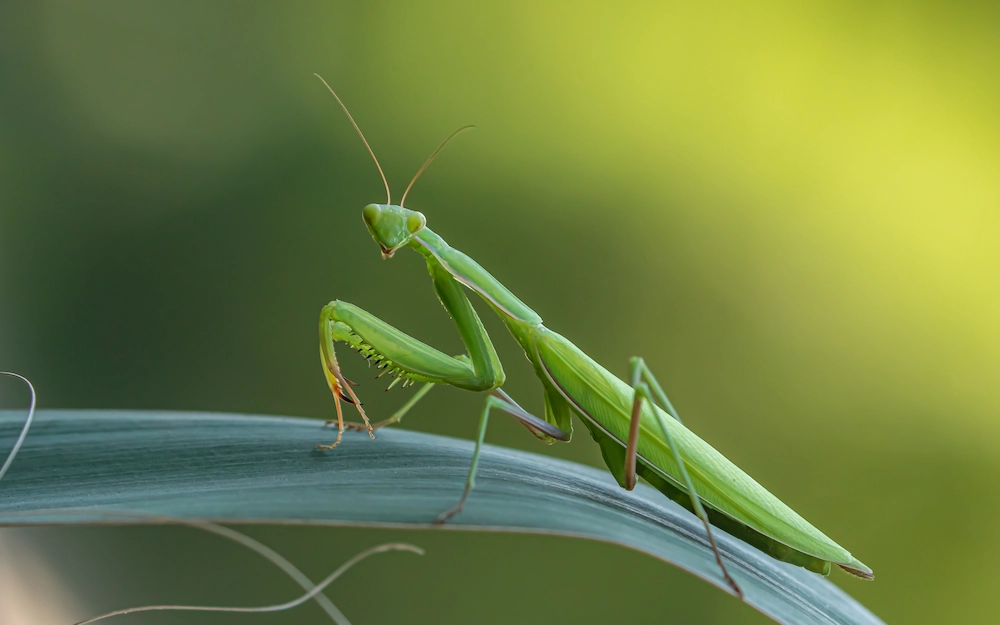
These green pests are often regarded as gentle giants, but smaller bugs wouldn’t agree with this assessment at all. Praying mantises patiently wait for their prey to wander nearby, then strike with their spiked forelegs. This ambush happens so quickly that the prey doesn’t have time to react before they’re impaled. Talk about a sneaky threat!
Praying mantises usually stick with their bright green coloring, but they can slightly adjust the shade to match different plants. Since mantises hide near plants and trees to be near their prey, these green pests need to be as inconspicuous as possible. This is tough to do when mantises are 2 to 3 inches long and isolate themselves as they age. There’s one generation of praying mantises per year, so get ready to see those eggs hatch this spring!
Southern Green Stink Bugs
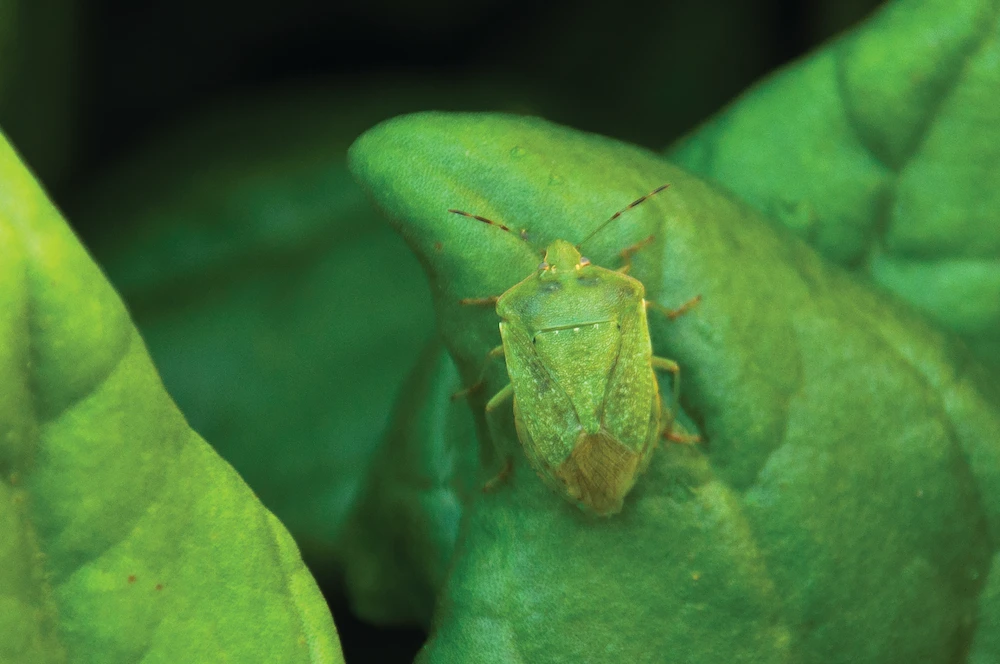
Stink bugs already aren’t a desirable pest (it’s in the name, after all), and the green hue of this species does little to help their reputations. Southern green stink bugs are 3/4 of an inch long and have a hard shell over their delicate wings. Their piercing mouthparts help them easily devour their favorite foods while they use their green coloring as camouflage.
Southern green stink bugs are a major threat to plants since they start feeding well before any harvest season. They start eating in early April once they emerge from their overwintering spots. These green pests often target fruits, vegetables, stems, cotton, and foliage. Any fruit or vegetable they eat is ruined because of their toxic saliva that’s injected into everything they eat. The produce is left with dimples, lesions, and depressions that can’t be removed.
Tomato Hornworms
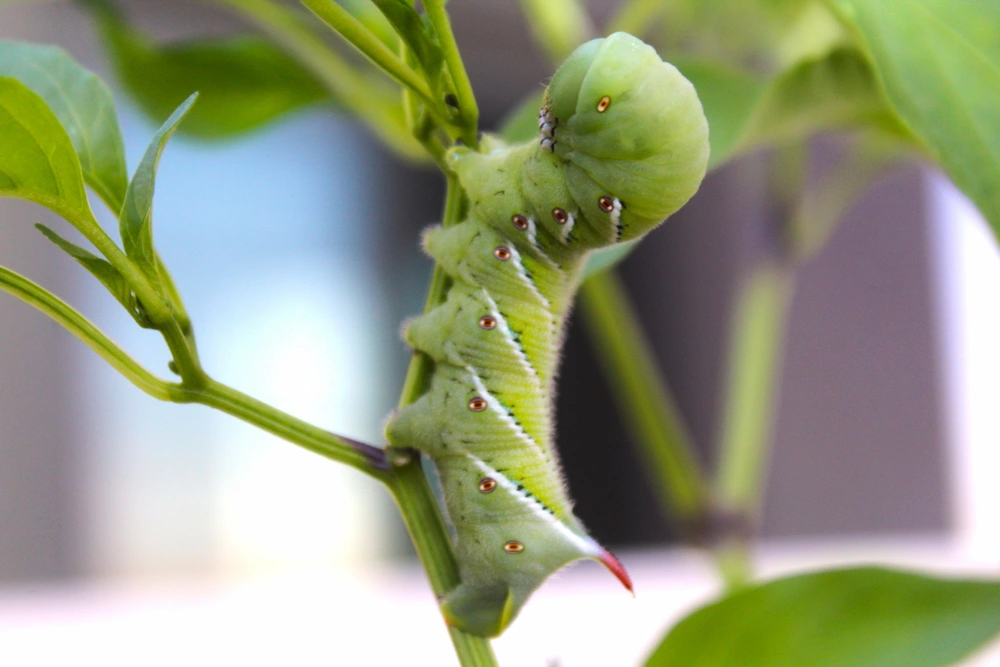
These massive caterpillars look like a cartoon pest, but their destructive diets aren’t fun at all. Tomato hornworms are 3 to 4 inches long and have a dark “horn” on their rears. Their vivid green coloring is offset by the diagonal white stripes that decorate their entire bodies. Tomato hornworms become sphinx moths that lay eggs underneath leaves to begin the cycle again.
Basically, tomato hornworms eat all the time. They need to fatten up for their upcoming transformations, but their ravenous appetites are incredibly frustrating for us. These green pests eat leaves and hearty crops, like tomatoes, potatoes, and peppers. If you notice a lot of chewed and missing leaves from a plant, it could be the work of tomato hornworms. The only bright side to a invasion is that these caterpillars are easily plucked off by hand.
You Don’t Need Luck When You Have Romney!
Just because today is St. Patrick’s Day doesn’t mean you have to rely on luck to get you through a pest invasion! The highly-trained technicians of Romney Pest Control target each pest problem with a customized combination of treatments that will actually get to the root of the issue. Whether you’re battling garden pests, bloodsucking bugs, or food-loving invaders, Romney has long-lasting pest solutions for you. Contact us today for a free quote on our reliable services — you’ll be glad you did!
Citations
Greenbug, aphid. (n.d.). Texas A&M AgriLife Extension. Retrieved March 6, 2025, from https://texasinsects.tamu.edu/greenbug-aphid/
Green lacewing. (n.d.). Texas A&M AgriLife Extension. Retrieved March 6, 2025, from https://texasinsects.tamu.edu/green-lacewing/
Hardy, M. (2024, July 9). Welcome to hot katydid summer. Texas Monthly. Available at https://www.texasmonthly.com/travel/welcome-to-hot-katydid-summer/ (Accessed on March 6, 2025).
Harney, C. (2022, March 17). Mean green camouflage machines: Green insects that are camouflage experts. Green Pest Services. Available at https://greenpestservices.net/mean-green-camouflage-machines-green-insects-that-are-camouflage-experts/ (Accessed on March 6, 2025).
Praying mantis. (n.d.). Texas A&M AgriLife Extension. Retrieved March 6, 2025, from https://texasinsects.tamu.edu/praying-mantis/
Rice, L. (2019, September 25). In the battle against garden pests, green lacewings are among the good guys. Texas Standard. Available at https://www.texasstandard.org/stories/in-the-battle-against-garden-pests-green-lacewings-are-among-the-good-guys/ (Accessed on March 6, 2025).
Tomato hornworm. (n.d.). Texas A&M AgriLife Extension. Retrieved March 6, 2025, from https://texasinsects.tamu.edu/tomato-hornworm/
Tomato hornworms. (n.d.). Grangetto’s Farm & Garden Supply. Retrieved March 6, 2025, from https://grangettos.com/blogs/pests-and-diseases-20/tomato-hornworms

